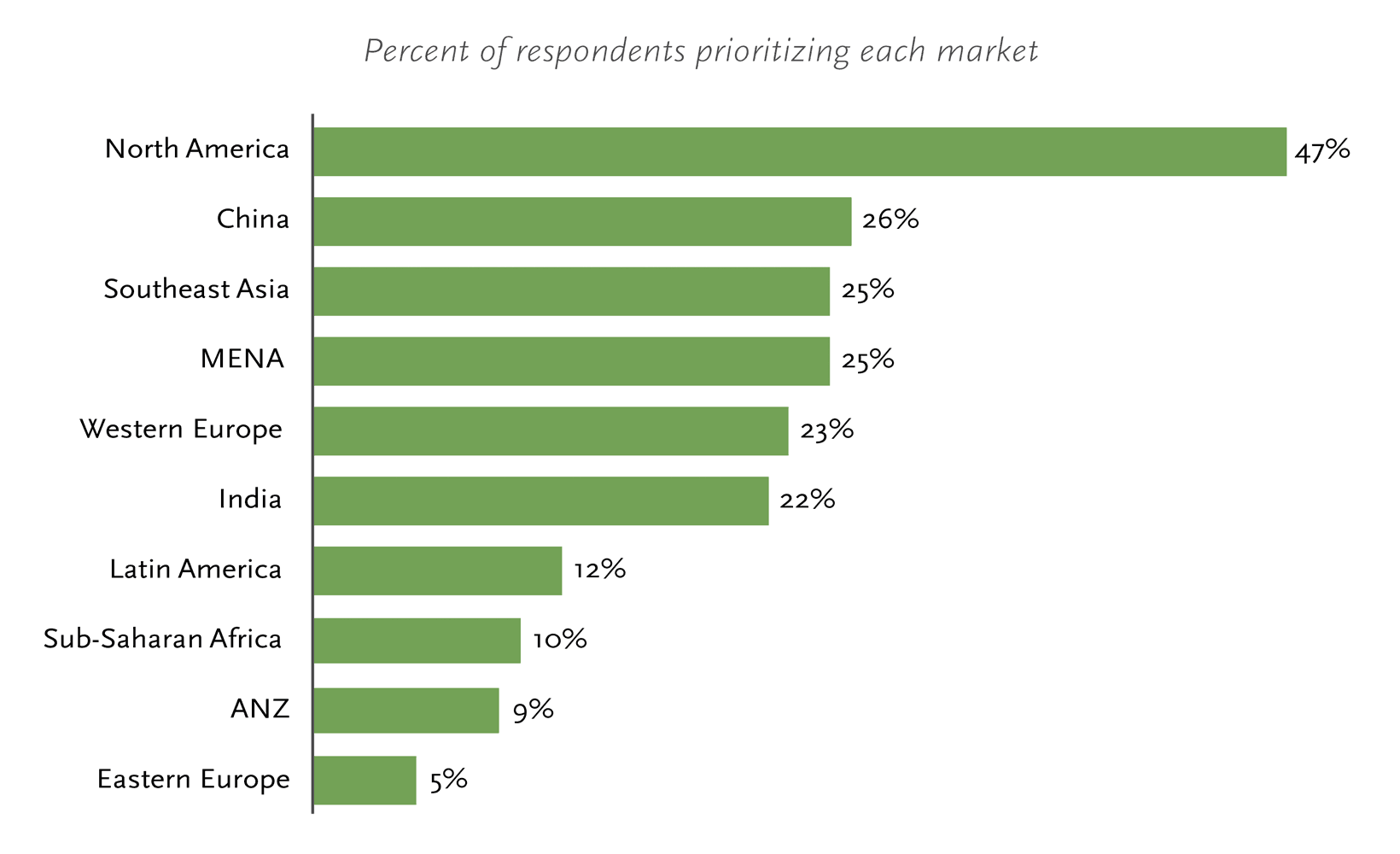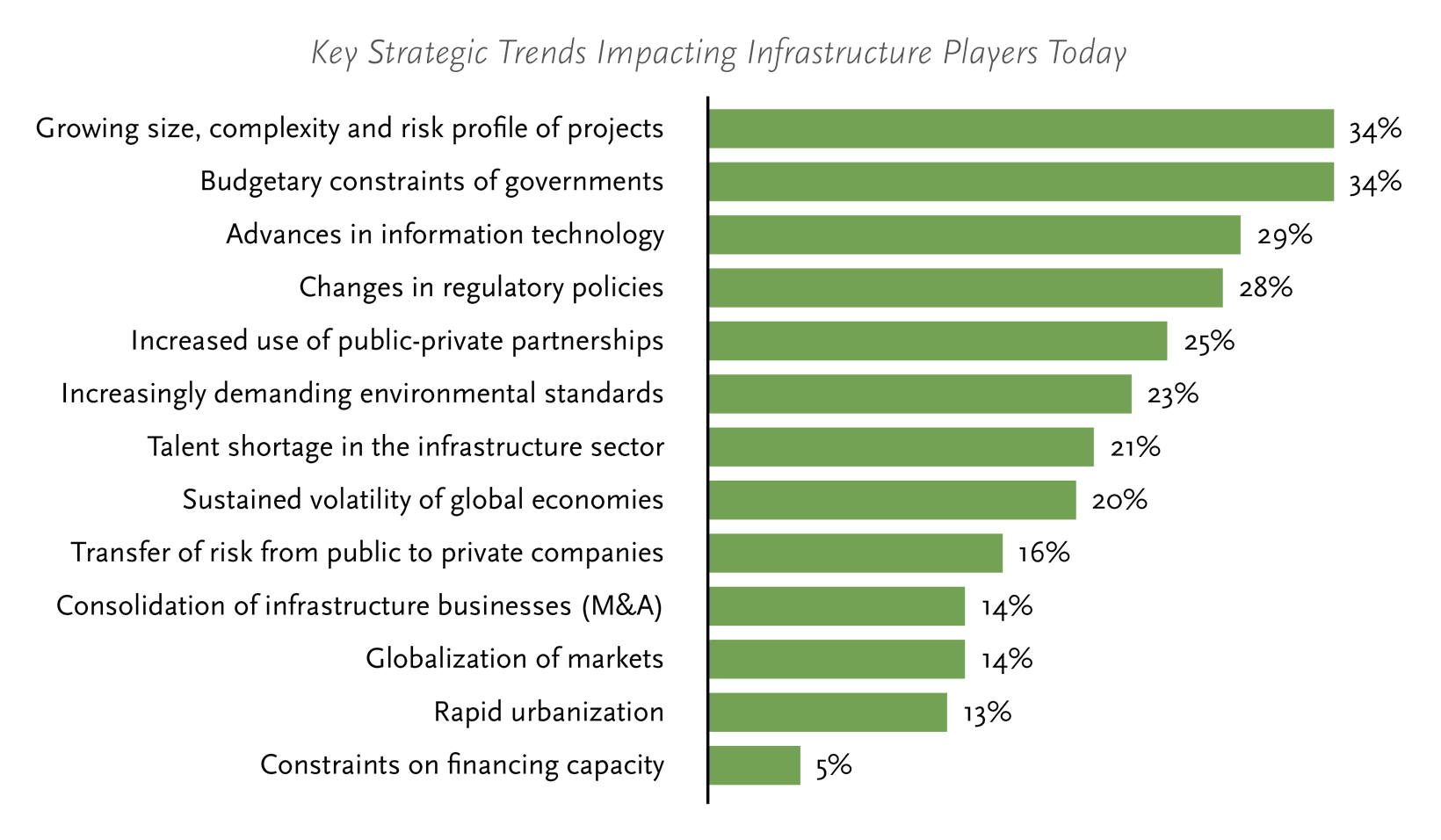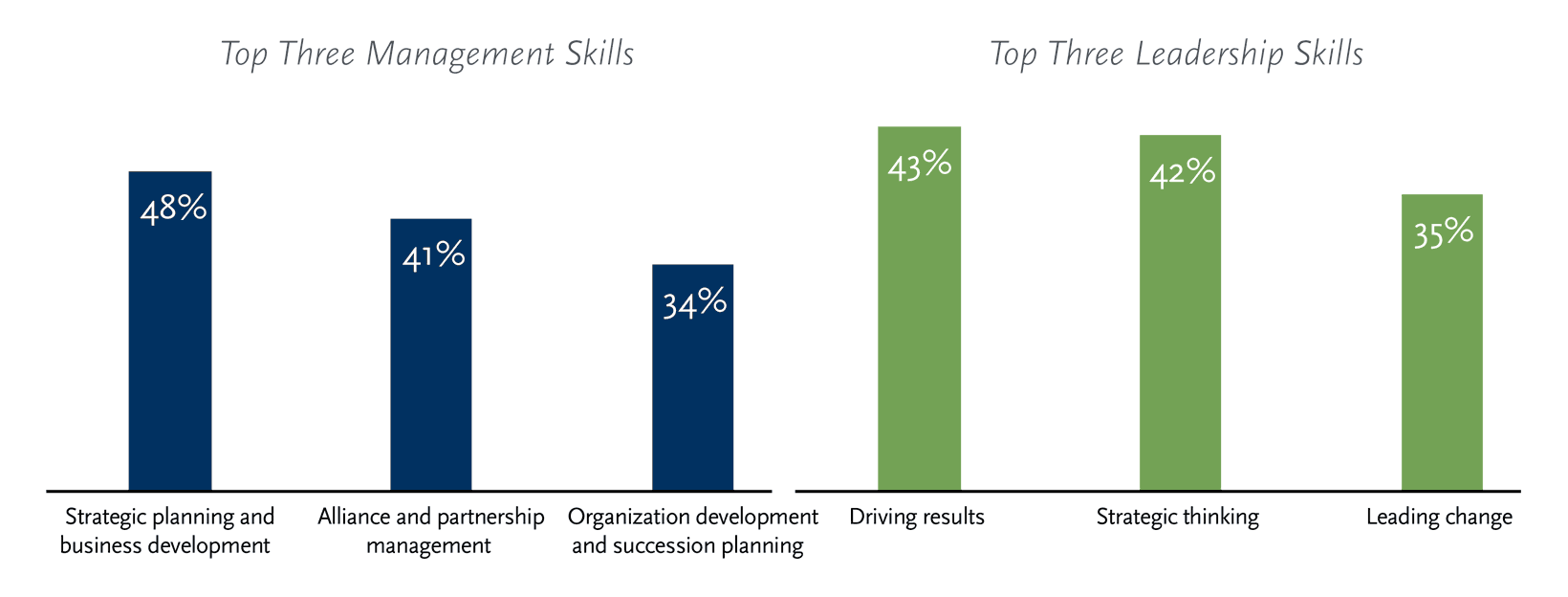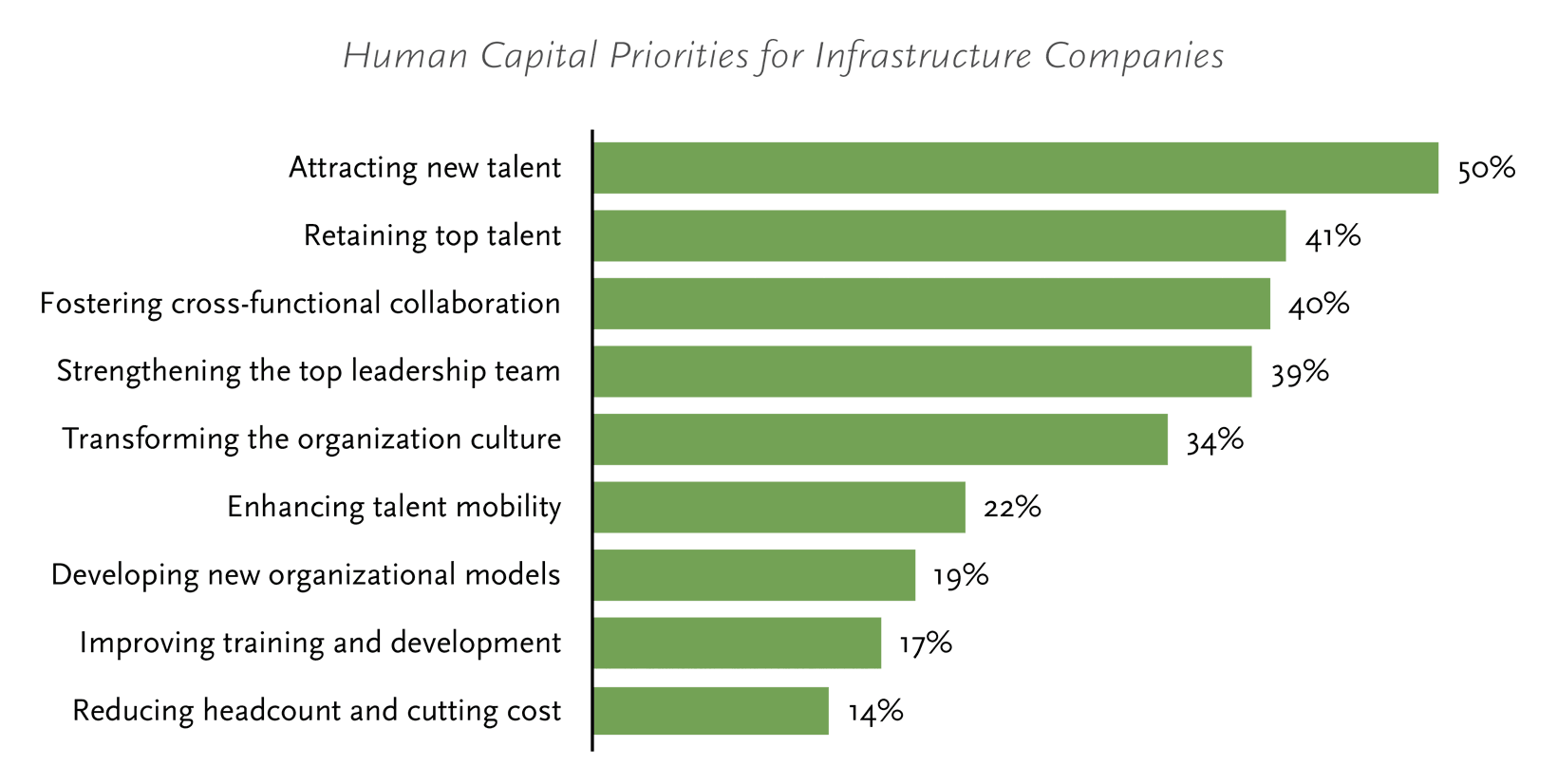In today’s global, digitally charged world, infrastructure projects are taking on new dimensions, while the industry is shifting to meet new and varied needs. The infrastructure industry faces both internal challenges, such as talent shortages, and external pressures, such as keeping pace with technology advancements.
To gain insight into the industry’s current state, Spencer Stuart interviewed 10 CEOs or chairmen of infrastructure companies across North America, Europe and Asia Pacific and surveyed globally more than 100 infrastructure CEOs, CFOs and board members, across engineering and construction, financial investors, asset operators and equipment and material suppliers. The findings reveal a sector on the cusp of significant change. We observed:
- An industry challenged with changing market conditions, including new funding models, increasing regulations and locationspecific issues.
- An evolving leadership profile, requiring first-rate management of teams as well as projects, a focus on the consumer and a commercial, strategic, technology and media skill-set suitable to managing increased demands from new and existing stakeholders.
- The need for an organizational capability aimed at attracting and retaining talent, while also further developing existing talent.
Infrastructure business leaders must guide their companies through a rapidly hanging marketplace — but they need to rely on skilled professionals from a variety of disciplines to ensure they are delivering to customers’ needs. And delighting customers is an ever-growing challenge; infrastructure leaders have to be increasingly cognizant of perceptions among the consumers that use them, not just the governments that commission them. As observed by Richard Parry-Jones, the former chairman of Network Rail who currently chairs Kelda Holdings, “In infrastructure it is very hard to win more customers through surprise and delight, but easy to lose them if you slip in a minor way in delivering a service. Invisible excellence is taken for granted.”
It’s a challenging marketplace. But with the right business model and leadership, infrastructure companies can thrive.
Infrastructure in a Turbulent World
With technology driving rapid change in every sector and every part of the world, the infrastructure industry has a challenge on its hands: How to design and build projects that meet stakeholders’ needs while incorporating the newest technologies and employing efficient design and construction processes? Moreover, how can infrastructure leaders accomplish these aims in light of changing regulations and tight financial constraints?
The overall market outlook for infrastructure development is positive. Our research points to two sweet spots for infrastructure projects: brownfield construction in developed countries — particularly in North America — and greenfield development in emerging
markets.
Top-cited challenges are the growing size, complexity and risk tied to infrastructure development, closely followed by budgetary constraints and new technology developments.
The digital shift
Like other sectors, the infrastructure industry is being transformed by a wave of new and evolving technologies, which cannot only transform the speed and effectiveness of new projects, but also can lead to a more efficient use of existing assets. These technologies may shift the emphasis from civil to electrical and mechanical engineering. Forty-four percent of survey respondents felt that their board needs to improve its knowledge and understanding of digital trends.
“The ‘paperless building-site’ is rapidly becoming real — from planning, calculation and project management to ongoing documentation: Nothing will be done without computers. But this needs a lot of equipment and training before all the advantages can be realized,” said Karl-Heinz Strauss, CEO of Porr.
Dr. Thomas Birtel, CEO of STRABAG SE, added, “The answer definitely is the digitalization of project planning — ‘Building Information Modeling,’ or BIM. We call it ‘5D planning.’ Computer-aided design has grown up.”
But digitalization comes with a down side for the industry in terms of investment costs, including the equipment and training mentioned by Strauss. Birtel predicts some smaller companies might not have the scale to invest in supporting such a transition and may struggle to survive independently.
To extend its own ability to innovate within its R&D function, American Water often partners with smaller companies offering new technologies. “We help develop, pilot and test in our service areas, and when the technology is marketable, we can get a significant discount and, in some cases, we actually negotiate a small ownership in the company,” said CEO Susan Story.


Public-private partnerships
Another significant infrastructure trend is the shifting role of government, along with private partnerships and combined funding models. One driver is declining public funding — more than one-third of respondents cited governmental budgetary constraints as a critical strategic issue for the industry.
“We are facing the ‘reign of empty coffers’” noted Strauss. “Public authorities are cutting their expenses wherever possible, so we need to develop new business models, enhancing the private role.”
One of these models, public-private partnerships (PPPs), is becoming increasingly prevalent as a funding mechanism for vital infrastructure developments. PPPs can take different forms, but all place more of the financial risk for projects in the hands of the private sector. In some locations PPPs are taking on parts of project governance, and are helping to create more robust capital allocation processes.
“Some emerging markets in Southeast Asia are setting up public PPP centers of excellence to initiate, structure and coordinate with line ministries and lead the tender processes for PPP projects,” said Allard Nooy, CEO of InfraCo Asia. “There is no doubt PPPs will be a key driver for infrastructure development and implementation for the next five to 10 years.”

Increasing project complexity
Funding aside, another struggle for infrastructure companies is their ability to stay the course in the midst of lengthier, more complex projects that involve long planning horizons and may mean a longer time to recoup investments. The growing size, complexity and risk profile of projects was one of the top strategic trends facing infrastructure companies, cited by more than 30 percent of respondents.
As Alison Andrew, CEO of Transpower New Zealand, observed, “Positioning the right infrastructure at the right time is quite challenging. One challenge is the long planning horizon, coupled with long capital recovery cycles. How do you do it in an environment where future demands you are planning for could be quite unpredictable?”
Funding, increasing complexity and the added high-tech dimension make this a challenging, invigorating time to drive infrastructure developments.
Complex Times Require Outstanding Leaders
With the challenges facing infrastructure companies, the question of who is at the helm is more important than ever. Successful CEOs need new skills to guide the company through a complex marketplace. The consumer savvy, social-media-tuned, IT-capable infrastructure leader must be mindful of financial and regulatory concerns, and must be nimble at meeting the needs of multiple partners and stakeholders.

Strategic thinking
Taking the long-term view and envisioning all available options and scenarios is increasingly critical for infrastructure leaders, a theme echoed in both interviews and the survey results. Without this capacity, developments can go south rapidly.
“In infrastructure you need to make big capital decisions ahead of time,” said Andrew.
“But if you invest too early you end up with underutilized assets and that comes at a cost to the consumer. We need people who have strategic thinking and a long-term view, who can think through the options and consequences.”
She added, “‘Let’s build a shiny new asset’ is not always the right answer any more.”
Critical to strategic thinking is being open to new ideas and new information and pursuing novel ideas from inside and outside the company.
“Technical skill-sets in infrastructure company CEOs are still important because the management layer underneath is technical,” said Nooy. “But the ability to learn is key.”
USG Boral CEO Frederic de Rougemont concurred, adding, “The CEO cannot know everything, but a lot of people still think that is the case. Now the ‘CEO hero’ is long gone.
Knowledge is everywhere today. You need to find people who can find and unlock knowledge both inside and outside of the organization.”
Commercial and financial mindset
The growth of public-private partnerships is causing a shift in the nature of projects. “We are moving from a public infrastructure/government mindset to a strong business mindset,” said Elaine Roberts, president and CEO of the Columbus Regional Airport Authority.
Becoming business-oriented means becoming consumer-oriented, which can be an acquired taste for infrastructure leaders. “Infrastructure leaders can lose sight of why they are there. They have a great public service ethic, but not an agile consumer-responsible behavior,” said Parry-Jones. He expects infrastructure leadership will begin to change with the times, noting, “I am looking for executive teams to have more consumer orientation — to understand what consumers are driven by.”
The shifting need for a commercial mind is becoming increasingly apparent in contract discussions. “Negotiating contracts is no longer about showing strength and keeping opportunities for claims, but all about partnering,” Birtel observed, “Negotiations have to aim at consensus and flexibility to get the project done.”
Collaboration and influencing skills
Another vital skill for infrastructure leaders is an ability to partner and collaborate effectively. Given the increasing number of functions and disciplines — financial, legal, risk management — needed to govern the business, CEOs need to build a skilled and agile senior team. Collaborating with and getting the best out of that team will be essential to leadership.
When it comes to driving infrastructure developments, “the leader needs to work with a lot of different people across a multitude of disciplines — civil engineers, mechanical engineers, specialist equipment suppliers, bankers,” said Chin Hua Loh, CEO of Keppel
Corporation. “You will never know their respective crafts better than the specialist practitioners, but you need to work with them, and you need to ask the right questions.”
Stakeholder management
Perhaps the most critical skill necessary for infrastructure leaders is an ability to nimbly manage the needs of multiple, varied stakeholders or, as Loh put it, the ability to speak credibly with customers and project managers. Infrastructure projects can have a major impact on communities, which can quickly harness the power of social media, so leaders have to be attuned to public opinion and be able to communicate effectively through different media platforms.
“You need to communicate both using the private sector and public sector language,” said Nooy. “If you have the ability to communicate with both, you’re able to get your point across.”
The ability to work with various stakeholders is requirement for moving up the ranks of
American Water, said Story. “Our leaders have a lot of autonomy at the state level, because being a successful utility in California can be very different than being a successful utility in Pennsylvania. It requires not only a technical competence and a leadership competence to be able to lead people and establish a vision, but also a sharp focus on customers along with the political acumen to balance the needs of employees, customers, regulators, investors and elected officials.”
Indeed, perhaps for infrastructure leaders, the most important new skill involves walking that tightrope between public and private, ensuring everyone comes out happy in the end.
“What is important is understanding trends and being able to connect the dots. It may be as important as knowing how to design and build a solution to meet the customers’ needs,” said Loh.
Building An Organization for the Future
A challenge for infrastructure companies responding to changes in the industry is attracting and retaining the talent with the right mix of leadership and technical skills. A number of survey respondents reported that an infrastructure talent shortage is a key strategic issue for the industry. The shortage of skills is broad, including tradesmen, engineers, project managers, commercial and financial leaders, technical experts as well as general managers. How can infrastructure companies become better at building the teams they need?

Injecting new perspectives
Infrastructure companies have tended to promote from within, but increasingly executives see a need to strategically recruit from outside the company and even outside the sector. More than half of survey respondents said attracting new talent is a human capital priority, more than any other talent need.
“Quite a few infrastructure companies have tended to promote from within. The same people pop up at different companies. There’s not a lot of cross-sector movement going on,” Parry-Jones observed. “As a result, people can be blindsided as to what is going on in the rest of the world. They don’t deliver as much value to the shareholders and customers, which makes them vulnerable to a competitor who has that insight.”
He concluded, “It’s important for recruiting and personal development strategy to get sensible infusion of talent from outside the industry. That’s not to say go overboard, but to get the balance better.”
This is increasingly relevant to airport developments for instance, as they expand into new non-airline revenues. Injecting a more entrepreneurial mindset into the organization will be critical, said Roberts. “Airports are like small cities, so we recruit skill-sets from all kinds of industries. Airports need to do more and more to enhance traditional revenues with non-airline revenues to be self-sufficient. We need people who think like this and are entrepreneurial,” she said.
The diversity of talent is not only welcome, it also is necessary in an industry facing changes on multiple fronts. Engineering skills will always be critical, but increasingly IT savvy, legal experience and finance management skills will be must-have skill-sets. Talent from outside the infrastructure industry can help revitalize the sector on those dimensions — but that also means competing in the talent market against top banks, law firms and consultancies as Strauss points out.
Outsiders must be selected with an eye to their fit with the culture and their willingness to learn a complex and technical business. “The industry builds for 30 years and is generally risk averse, afraid of liabilities. Bringing people from outside the industry helps, but there can be tissue rejection. We need people with humility and who will listen,” said de Rougemont.
As companies bring in outsiders, recognizing what they need to learn — and what they can teach the organization — will help ensure cross-pollination and skill-building.
“How do you balance the company history with enough new ideas and new ways of thinking? In this industry, loyalty and longevity are valued — but people don’t always know what good looks like,” said Andrew. “Internal leaders can help impart company values and culture to new external hires, but there can be some give and take. The challenge for people who come from outside is to show internals another perspective. External hires need to become coaches for the internals.”
Developing and retaining top talent
Throughout the ranks of infrastructure professionals, cultivating a broad leadership skillset helps raise the talent bar.
“Infrastructure companies are populated by people with good technical skills who are intelligent, but not emotionally intelligent — and this results in poorer industrial relations, poorer talent retention and poorer customer orientation,” said Parry-Jones.
Ensuring skills are on par with other industries, and that workers are in tune with external challenges, can help. When it comes time to hire or make appointments, taking the extra step of benchmarking the position, both internally and externally, helps immensely, even the intent is to hire from within.
“We like to grow our own timber,” said Loh. “But when we promote from within, we do exhaustive benchmarking to determine if this person is the best for the job relative to someone outside.” That added effort acts as a safeguard against excessive insularity, while also enforcing high standards for skills and talent.
Cultivating a blend of skills and expertise is necessary, but specific pain points can and should be addressed as well. For infrastructure companies, a pressing concern involves the pipeline of engineers, who are the core of the workforce. They are essential for an infrastructure company — but engineers are also on the front lines when it comes to managing sweeping technology change.
Birtel reported, “The most important challenge we are facing is a direct result of digitalization: We need to find the people who can handle it, who are used to working in the digital sphere. It is not that easy to find enough construction engineers who are trained that way.”
Even when skilled talent is plentiful, training individuals to move beyond their core-skill roots is essential. For example, Philip Aiken, chairman of both Balfour Beatty and AVEVA, said, “We observe engineers who are very capable at engineering, but who don’t get honed in leadership as early as they might.”
Any time talent shortages are present, employers must build a compelling, solid value proposition to attract and retain workers. This is particularly true for infrastructure companies, which must compete with private enterprises for rare skills.
“You have to treat people as though they are a more precious commodity,” said Aiken. “For too long, people threw money at this issue and didn’t think about the social issues.
But to attract and retain people, you have to give then a career path that meets their personal needs.”
Growth opportunities, clear career progression and a strong mix of benefits can go far toward attracting talented professionals and keeping them in house. But sometimes the best reward is the work itself.
“The best way to attract people is to have great projects,” said Aiken. “Money and conditions are important, but the best people want to work on the best projects.”
Conclusion
The infrastructure industry is changing fast and dramatically, transforming itself in response to technology advancements, growing risk and complexity, and the need for innovative funding mechanisms. In light of these industry changes, a new leadership profile is emerging that emphasizes the following:
- Strategic thinking. The ability to consider all available options with a long-term lens and draw on the best ideas wherever they come from is more critical than ever as projects become more complex and companies take a larger share of the risk.
- Commercial and financial mindset. The growth of public-private partnerships and the growing financial stake of projects require a strong business mindset and commercial savvy.
- Collaboration and influencing skills. Successfully leading an infrastructure business today requires executives to be able to unlock knowledge and capabilities across the entire organization and to lead cultural change that places consumer-awareness and social impact high on the agenda.
- Stakeholder management. Infrastructure leaders must be able to nimbly manage the needs of an increasingly broad set of stakeholders — both private and public — and speak credibly to all.
For many infrastructure companies, the answer to the human capital challenge may lie in the thoughtful infusion of talent from outside the industry. Others will keep on growing their own talent and work hard to retain them. In all cases, to attract and retain outstanding leaders and experts and build resilience in the face of shifting industry trends, infrastructure organizations will need develop a strong value proposition, provide clear career development opportunities and, most importantly, get to work on the most compelling and ground-breaking projects.
Contributors
Philip Aiken, Chairman, Balfour Beatty and AVEVA
Alison Andrew, CEO, Transpower New Zealand
Dr. Thomas Birtel, CEO, STRABAG
Frederic de Rougemont, CEO, USG Boral
Chin Hua Loh, CEO, Keppel Corporation
Allard M. Nooy, CEO, InfraCo Asia
Richard Parry-Jones, Chairman, Kelda Holdings
Elaine Roberts, President & CEO, Columbus Regional Airport Authority
Susan Story, CEO, American Water
Karl-Heinz Strauss, CEO, Porr